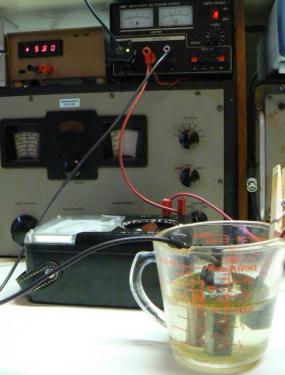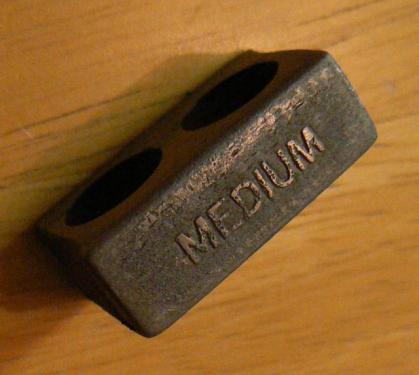08-28-2017, 07:01 PM
Good idea and both ingredients are usually on hand. Reminded me of the following:
I use approximately the same solution for permanent marking. Those greatly enlarged photos below show liitle teeny letters (0.1 inch high). They were etched on steel parts with the vinegar/salt solution and a power supply - I used about 5 volts at around 800 mA for those parts, if I recall correctly. (A 5V supply from an old desktop computer would be good). A sacrificial piece of the same material is required as a cathode.
The simple setup:

A couple of examples:

 etch3.jpg (Size: 59.87 KB / Downloads: 83)
etch3.jpg (Size: 59.87 KB / Downloads: 83)
The parts need to be clean (hot, soapy water followed by a hot rinse and drying). Then the lettering (transfer letters, ordered from the internet - many sizes available) applied. Dunk it in the solution, turn on the power supply and come back in about 45 minutes to remove and rinse the parts.
Areas where etching is undesirable can be masked off, for example by painting with shellac which can later be removed with a bit of alcohol. The depth of the etch is determined by current and the duration of the part in the solution.
 Sorry but the vinegar/salt reminded me of this old trick that I haven't used in four or five years
Sorry but the vinegar/salt reminded me of this old trick that I haven't used in four or five years
I use approximately the same solution for permanent marking. Those greatly enlarged photos below show liitle teeny letters (0.1 inch high). They were etched on steel parts with the vinegar/salt solution and a power supply - I used about 5 volts at around 800 mA for those parts, if I recall correctly. (A 5V supply from an old desktop computer would be good). A sacrificial piece of the same material is required as a cathode.
The simple setup:
A couple of examples:
 etch3.jpg (Size: 59.87 KB / Downloads: 83)
etch3.jpg (Size: 59.87 KB / Downloads: 83)
The parts need to be clean (hot, soapy water followed by a hot rinse and drying). Then the lettering (transfer letters, ordered from the internet - many sizes available) applied. Dunk it in the solution, turn on the power supply and come back in about 45 minutes to remove and rinse the parts.
Areas where etching is undesirable can be masked off, for example by painting with shellac which can later be removed with a bit of alcohol. The depth of the etch is determined by current and the duration of the part in the solution.
 Sorry but the vinegar/salt reminded me of this old trick that I haven't used in four or five years
Sorry but the vinegar/salt reminded me of this old trick that I haven't used in four or five years




